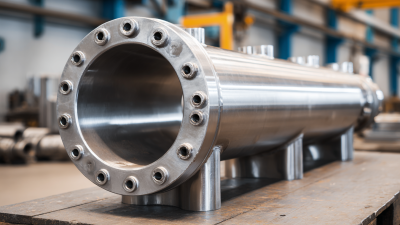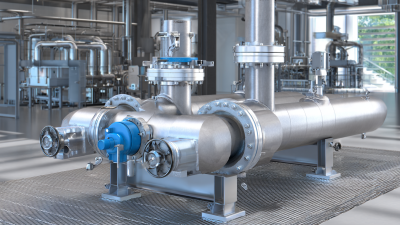Leave Your Message
In the realm of protein management, the role of Phe Exchangers has emerged as a pivotal topic for researchers and industry professionals alike. Dr. Emily Carter, a leading expert in biochemical engineering, once stated, "The efficiency of protein management hinges on our understanding of the intricate mechanisms behind Phe Exchangers." This underscores the necessity of delving into the operational principles and advantages of these essential devices.

The role of phenylalanine (Phe) exchangers in protein management has gained significant attention in recent years, particularly within industries focused on food and nutrition. According to the latest report by MarketsandMarkets, the global market for protein supplements is projected to reach $22.8 billion by 2025, highlighting the increasing demand for efficient protein management solutions. Phe exchangers are essential tools that optimize the amino acid profile in protein supplementation, ensuring that specific dietary needs, such as those for individuals with phenylketonuria (PKU), are effectively met.
In the food production sector, the application of Phe exchangers extends beyond nutritional supplements. A study published in the Journal of Nutritional Science indicates that incorporating Phe exchangers in food processing can enhance the bioavailability of essential amino acids, thereby improving protein quality. This advancement not only helps in creating products suitable for individuals with metabolic disorders but also caters to the growing consumer preference for healthier, protein-rich diets.
By harnessing the power of Phe exchangers, manufacturers can address nutritional gaps while complying with regulatory standards in safety and labeling, contributing to an overall improvement in food quality and health outcomes.
When evaluating the efficiency of phenylalanine (Phe) exchangers in protein purification processes, several key metrics emerge as vital indicators of performance. One of the most critical metrics is the dynamic binding capacity (DBC), which determines the maximum amount of protein that can be effectively captured by the resin at a specified flow rate. Recent industry reports indicate that advanced Phe exchangers can achieve a DBC as high as 70-100 mg/mL, depending on the specific application and operating conditions. This improved DBC not only enhances throughput but also optimizes resource utilization in bioprocessing.
Another essential factor to consider is the selectivity of the Phe exchanger for target proteins amidst complex mixtures. Selectivity is often quantified using the separation factor, which assesses the exchanger's ability to preferentially bind to the desired protein over contaminants. Current studies show that modern Phe exchangers can achieve separation factors exceeding 10, indicating their superior ability to isolate proteins with minimal interference from other molecules. Implementing these efficient Phe exchangers in purification workflows can significantly improve the yield and purity of important therapeutic proteins, thereby increasing the overall efficacy of the production process.
In the context of enhancing protein yield through more efficient management of phenylalanine exchangers (Phe exchangers), it’s pivotal to understand the underlying factors that can optimize their performance. By employing strategies that integrate advanced biotechnological methods and environmental considerations, we can significantly improve the efficiency of these systems. Just as blue-green spaces serve as a critical buffer against the adverse effects of climate change, optimizing Phe exchanger performance requires a multifaceted approach that addresses both biological and ecological factors.
Research highlights the importance of optimal conditions for protein expression and stability, akin to how blue-green spaces mitigate the effects of urban heat waves across different climatic zones. By analyzing the interactions between various environmental parameters and the operations of Phe exchangers, strategies can be developed that enhance yield while minimizing negative impacts. This comprehensive understanding not only aids in maximizing productivity but also aligns with broader sustainability goals in protein management, thus bridging the gap between agricultural practices and environmental resilience.
The implementation of Phe exchangers in biopharmaceutical production presents a unique opportunity to enhance efficiency while managing costs effectively.
Phe exchangers facilitate the selective removal of phenylalanine, an amino acid that can hinder certain production processes or compromise product quality. The ability to maintain optimal levels of phenylalanine not only streamlines production but also minimizes waste, allowing for a more sustainable approach to biopharmaceutical manufacturing.
Conducting a cost-benefit analysis reveals that the initial investment in Phe exchangers can be offset by the long-term savings realized through improved yields and reduced resource consumption. By optimizing protein management, companies can achieve higher production rates with less downtime, ultimately leading to a quicker return on investment. Additionally, these systems can enhance product consistency and reduce the risk of costly batch failures, making them an attractive option for biopharmaceutical companies aiming to improve their bottom line while adhering to stringent quality standards.
The landscape of protein management is rapidly evolving, and emerging trends in phenylalanine (Phe) exchanger technology are at the forefront of this transformation. As the demand for more efficient and sustainable protein production grows, innovative techniques and tools are being developed to optimize Phe exchange mechanisms. Recent advancements in biotechnology, including the use of synthetic biology and machine learning, are transforming how we understand and harness these processes, leading to improved accuracy and efficiency in protein management.
Moreover, the future of Phe exchanger technology lies in enhancing its adaptability and resilience in response to ever-changing environmental and market dynamics. Researchers are exploring the potential of smart Phe exchangers that can self-regulate based on real-time data, ensuring optimal performance even in variable conditions. By integrating renewable resources and developing more sustainable practices, these technological advancements not only promise to increase productivity but also to reduce the ecological footprint of protein management systems, paving the way for a more sustainable future in the food and bioproduct sectors.






